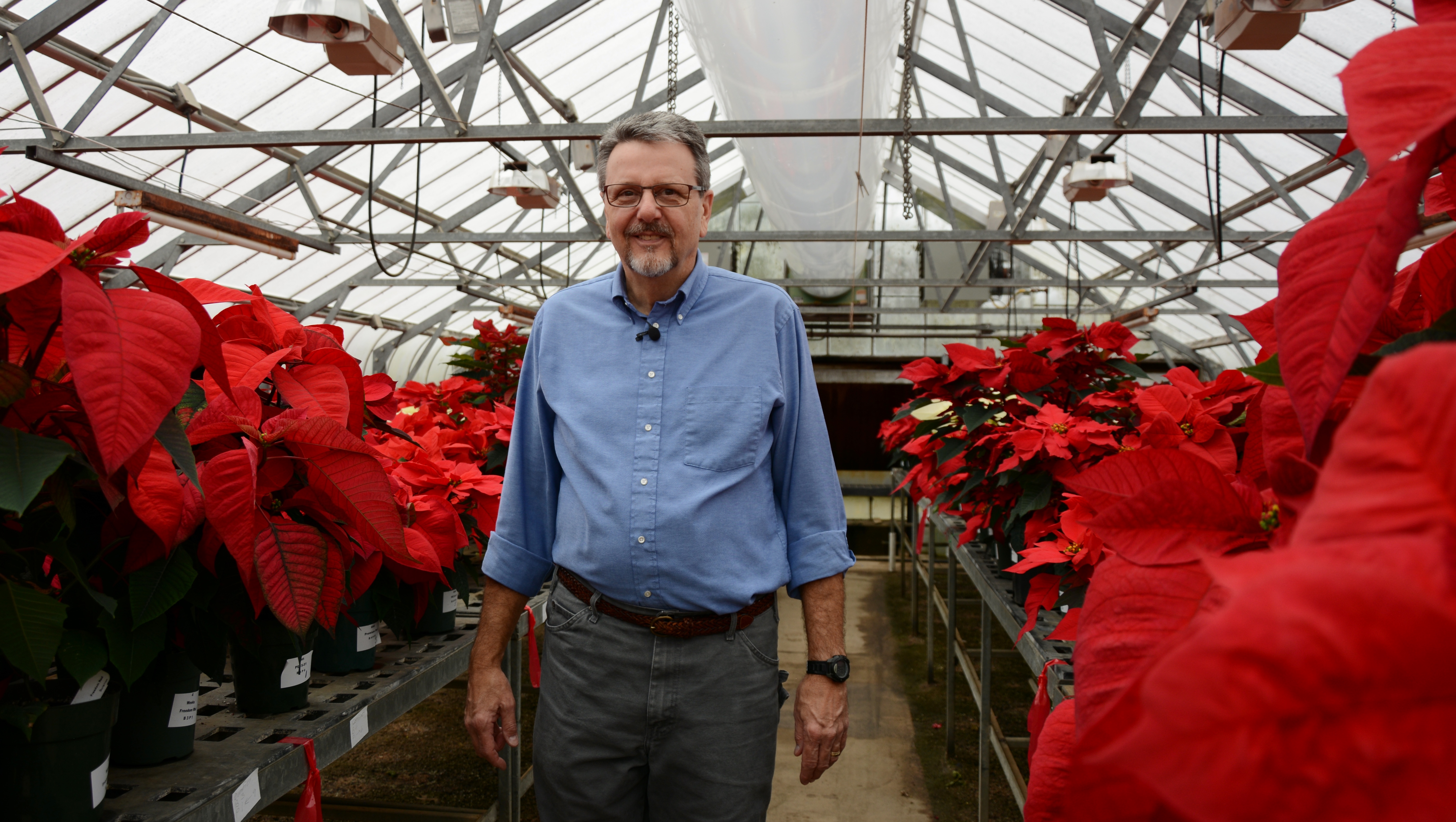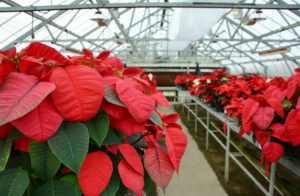Farm & Ranch
[AgriLife Today] Poinsettia trial shows effect of high temperatures on plant growth and flowering

By: Adam Russell
Writer: Adam Russell, 903-834-6191, [email protected]
- Contact: Dr. Brent Pemberton, 903-834-6191, [email protected]
OVERTON – Rows of vivid red poinsettias inside Greenhouse No. 4 at the Texas A&M AgriLife Research and Extension Center in Overton are as eye-catching as a flashing stop light.
Dr. Brent Pemberton, AgriLife Research ornamental horticulturist in Overton, began a trial of more than 30 varieties of the popular holiday flower associated with Christmas to determine how high temperatures affect the growth and flowering of the tropical perennial.
Poinsettias are grown in the fall for sales around the holidays, Pemberton said. The flower naturally sets its buds as days get shorter.
“Sometimes in Texas we can have warmer temperatures in late September and early October when all of this is happening and those high temperatures can have a deleterious effect on floral development and delay crops,” he said. “Producers need to have poinsettias peaking to within a week of a certain date. Typically stores want them before Black Friday, so they’ll ship them before Thanksgiving.”
For that reason, all commercial poinsettias are grown in greenhouses where producers can control temperatures and conditions to have the flowers peak according to contracts with buyers, Pemberton said.
Over the years, varieties have been developed that can tolerate higher temperatures in Texas and the southern U.S., Pemberton said. Trials have been ongoing for several years and there’s interest within the industry to continue research on poinsettias.
“Those breeding efforts continue, so what we are doing here is testing commercial breeding lines to look at the effects of high temperatures,” he said. “The end product will be more heat-tolerant varieties that are good for Texas growers and consumers.”
https://www.youtube.com/watch?v=r8K5vxYHkIc
Pemberton received the plants in early September. The trial placed varieties in separate greenhouses with daily average temperatures of 72 degrees and 82 degrees.
Poinsettias in higher temperatures during floral initiation tend to stretch and do not develop bracts, which provide the color, as quickly or in preferred numbers, Pemberton said.

Most all commercial poinsettias are grown in greenhouses which allows producers to control their growth and when they flower, ensuring they peak for holiday season sales. (Texas A&M AgriLife Extension Service photo by Adam Russell)
Bracts, the recognizable red leafy showcase for the plant, in red varieties, are actually leaves that change physiologically during the natural development of the plant, Pemberton said.
Many plants in the higher temperature greenhouse have yet to flower, he said.
“We treat them with high temperatures for several weeks which would be extreme for production greenhouses but this helps breeders make advances in looking at varieties best suited for Texas growers,” he said.
Under lower average daily temperatures, poinsettias grew to desirable heights, 12-18 inches for plants in 6-inch pots, and bracts were much more numerous and deep vibrant red, Pemberton said.
“They’re a much more desirable plant both from a grower standpoint and for shipping and placement in a retail setting and something that consumers will enjoy more as a decorative plant in their home,” he said.
-30-
Find more stories, photos, videos and audio at http://today.agrilife.org
Farm & Ranch
Acorn Toxicity

By Barry Whitworth, DVM, MPH
With the prolonged drought, most pastures in Oklahoma end up in poor condition. With the lack of available forage, animals may go in search of alternative foods.
If oak trees are in the pastures, acorns may be a favorite meal for some livestock in the fall. This may result in oak poisoning.
Oak leaves, twigs, buds, and acorns may be toxic to some animals when consumed.
To read more, pick up a copy of the November edition of North Texas Farm & Ranch magazine, available digitally and in print. To subscribe by mail, call 940-872-5922.

Farm & Ranch
Silver Bluestems

By: Tony Dean
There are a handful of grasses on North Texas grazing lands ranchers need to know, not because they are highly desirable, but rather because they are not of much value. I call them “decom” plants, which is am acronym for “Don’t Ever Count On Me.” Silver bluestem is a “decom” grass.
Silver bluestem is a perennial which grows in all areas of Texas. It can survive in almost all soil types, and in full sun conditions or in semi shade. It grows up to three feet tall and is easily recognized with the presence of the white fuzzy seed head. Also, one of the identifying characteristics of Silver bluestem is a bend in the stems at each node, causing the plants to take on a rounded shape as they mature.
To read more, pick up a copy of the November edition of North Texas Farm & Ranch magazine, available digitally and in print. To subscribe by mail, call 940-872-5922.

Farm & Ranch
Meanwhile Back At The Ranch

By: Rayford Pullen
Fall is here which means winter is closing in on us and before we officially get into winter, we need to make sure our factories are either producing or will be producing in a few months.
We have been pregnancy testing our cows this fall and if they are not bred or nursing a calf, we are bidding them adios. With annual costs somewhere between $900.00 and $1,000.00 per cow, those cows not producing a live weaned calf are costing us quite a bit.
To read more, pick up a copy of the November edition of North Texas Farm & Ranch magazine, available digitally and in print. To subscribe by mail, call 940-872-5922.
-

 Country Lifestyles2 years ago
Country Lifestyles2 years agoScott & Stacey Schumacher: A Growth Mindset
-

 Country Lifestyles8 years ago
Country Lifestyles8 years agoStyle Your Profile – What your style cowboy hat says about you and new trends in 2017
-

 HOME8 years ago
HOME8 years agoGrazing North Texas – Wilman Lovegrass
-

 Equine1 year ago
Equine1 year agoThe Will to Win
-

 Country Lifestyles5 years ago
Country Lifestyles5 years agoAmber Crawford, Breakaway Roper
-

 Outdoor9 years ago
Outdoor9 years agoButtercup or Primrose?
-

 Country Lifestyles8 years ago
Country Lifestyles8 years agoJune 2016 Profile – The man behind the mic: Bob Tallman
-

 Country Lifestyles8 years ago
Country Lifestyles8 years agoDecember 2016 Profile, Rusty Riddle – The Riddle Way




